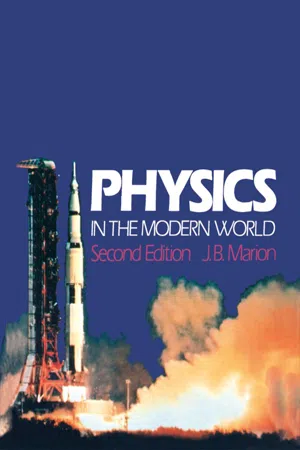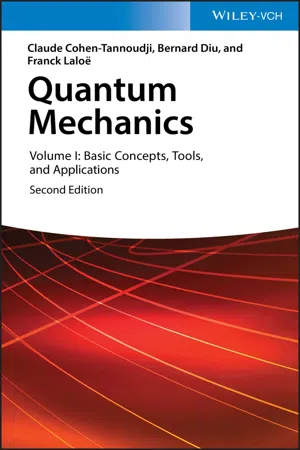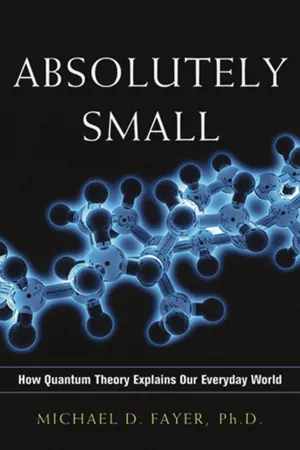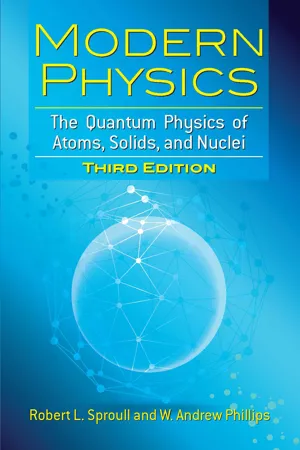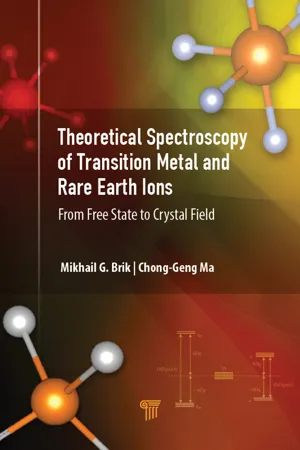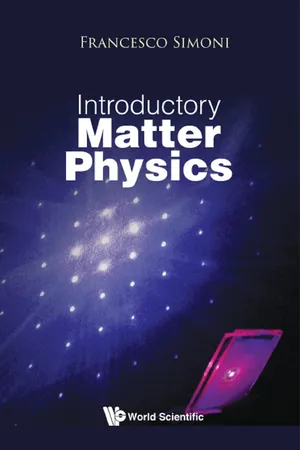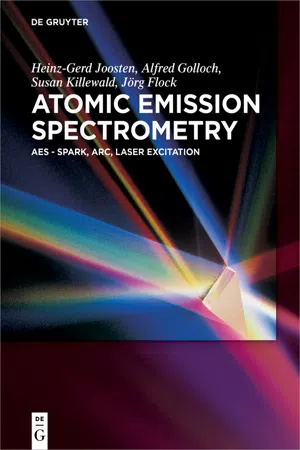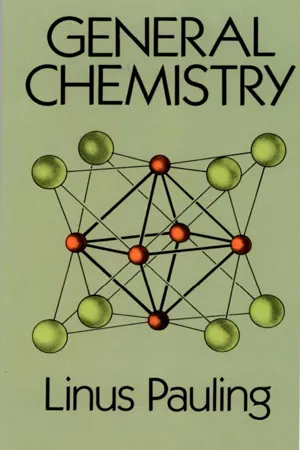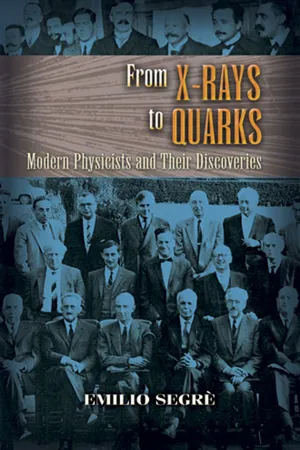Physics
Quantum Model of Hydrogen Atom
The quantum model of the hydrogen atom describes the behavior of electrons in the atom using quantum mechanics. It incorporates the concept of quantized energy levels and wave-particle duality, allowing for a more accurate understanding of the electron's position and energy. This model provides a framework for predicting and explaining the spectral lines observed in hydrogen's emission and absorption spectra.
Written by Perlego with AI-assistance
Related key terms
Related key terms
1 of 4
Related key terms
1 of 3
9 Key excerpts on "Quantum Model of Hydrogen Atom"
- eBook - ePub
- Jerry Marion(Author)
- 2012(Publication Date)
- Academic Press(Publisher)
18THE MODERN VIEW OF ATOMS
Publisher Summary
Atoms emit radiation only with certain definite wavelengths, and each atomic species has its own characteristic spectrum of emitted radiation. This chapter explains the Bohr model of the hydrogen atom. It describes the relative energies for several of the hydrogen atom states. The state of an electron in an atom is completely specified only when all four quantum numbers are given. The chapter discusses the quantum numbers and their significance. It focuses on the quantum theory of the hydrogen atom. The chapter explains the need of new principle in the periodic table and Pauli’s exclusion principle. Light from an ordinary source consists of spontaneous photons that are emitted in random directions. On the other hand, laser photons are emitted in a narrow beam that retains its small size even though it travels a substantial distance through space.In the preceding chapter we traced the development of quantum theory from the viewpoint of particles and photons. Actually, there was a parallel historical development concerned with the quantum properties of atoms. We now examine this approach to the problem, and we see, finally, how the two lines of attack merge into a single successful quantum theory.By 1912 new and important discoveries concerning atoms and radiation had been accumulating for about 15 years. The electron had been identified by Thomson in 1897. Planck had made his quantum hypothesis in 1900, and Einstein had adopted this idea in 1905 to explain the photoelectric effect. Rutherford’s nuclear model of the atom was proposed in 1911. And in that year, a young Dane, Niels Bohr (1885–1962), came to work in Thomson’s laboratory at Cambridge.Bohr wondered what connection there could be between the quantized nature of radiation and the structure of atoms. Experiments had shown that atoms emit radiation only with certain definite wavelengths and that each atomic species has its own characteristic spectrum of emitted radiation. Bohr concluded that if an atom could emit radiation only with definite wavelengths (that is, with discrete energies), the internal energy of the atom must also be quantized. Thomson, Bohr’s host at the Cavendish Laboratory, would not accept the idea that atoms possess a quantized structure–he much preferred a classical atomic model. Several sharp arguments over the matter took place and this unpleasantness caused Bohr to decide to leave Cambridge and spend the remainder of his fellowship in a more forward-looking atmosphere. Bohr chose Manchester, where Rutherford and his colleagues were investigating atomic structures with radioactivity methods. - eBook - ePub
Quantum Mechanics, Volume 1
Basic Concepts, Tools, and Applications
- Claude Cohen-Tannoudji, Bernard Diu, Franck Laloë(Authors)
- 2020(Publication Date)
- Wiley-VCH(Publisher)
p is on the order of 1/1 800). This means that the center of mass of the system is practically at the position of the proton, and that the relative particle can be identified, to a very good approximation, with the electron. This is why we shall adopt the slightly inaccurate convention of calling the relative particle the electron and the center of mass the proton.C-2. The Bohr model
We shall briefly review the results of the Bohr model, which relate to the hydrogen atom. This model, which is based on the concept of a trajectory, is incompatible with the ideas of quantum mechanics. However, it allows us to introduce, in a very simple way, fundamental quantities such as the ionization energy EI of the hydrogen atom and a parameter which characterizes atomic dimensions (the Bohr radius a0 ). In addition, it so happens that the energies En given by the Bohr theory are the same as the eigenvalues of the Hamiltonian we shall calculate in § C-3. Finally, quantum mechanical theory is in agreement with some of the intuitive images of the Bohr model (§ C-4-c-β).This semi-classical model is based on the hypothesis that the electron describes a circular orbit of radius r about the proton, obeying the following equations:(C-8 )(C-9 )(C-10)The first two equations are classical ones. (C-8 ) expresses the fact that the total energy E of the electron is the sum of its kinetic energy µv2 /2 and its potential energy —e2 /r. (C-9 ) is none other than the fundamental equation of Newtonian dynamics (e2 /r2 is the Coulomb force exerted on the electron, and v2 /r is the acceleration of its uniform circular motion). The third equation expresses the quantization condition, introduced empirically by Bohr in order to explain the existence of discrete energy levels: he postulated that only circular orbits satisfying this condition are possible trajectories for the electron. The different orbits, as well as the corresponding values of the various physical quantities, are labeled by the integer n - eBook - ePub
- Michael D. Fayer(Author)
- 2010(Publication Date)
- AMACOM(Publisher)
The Hydrogen Atom: Quantum TheoryIN 1925 SCHRÖDINGER AND HEISENBERGseparately developed quantum theory. Their two formulations are mathematically different, but their theories are rigorous and form the underpinning of modern quantum theory. At about the same time, Dirac made major contributions as well. First, he presented a unified view of quantum theory that showed that the Schrödinger and Heisenberg theories, while mathematically different, were equivalent representations of quantum mechanics. In addition, he developed a quantum theory for the hydrogen atom that is also consistent with Einstein’s Theory of Relativity. The formulation by Schrödinger is the most often used to describe atoms and molecules. Therefore, most of our discussions, starting with the hydrogen atom and then going on to larger atoms and molecules, will be based on the concepts and language that is inherent in the Schrödinger approach.THE SCHRÖDINGER EQUATION
We used a very simple but correct mathematical method for obtaining the energy levels of the particle in the box and the wavefunctions, but the method we used is not general. For example, it cannot be used to find the energy levels and the wavefunctions for the hydrogen atom. In fact, the language we have been using, that is, wavefunctions and probability amplitude waves, comes from Schrödinger’s formulation of quantum theory. In 1925 Schrödinger presented what has come to be known as the Schrödinger Equation. The Schrödinger Equation is a complicated differential equation in three dimensions. We will not do the mathematics necessary to solve the Schrödinger equation for the hydrogen atom or other atoms or molecules. However, we will use many of the results to learn about atoms and molecules, beginning with the hydrogen atom.The solution of the hydrogen atom problem using the Schrödinger Equation is particularly important because it can be solved exactly. The hydrogen atom is a “two-body” problem. There are only two interacting particles, the proton and the electron. The next simplest atom is the helium atom, which has a nucleus with a charge of +2 and two negatively charged electrons. This is a three-body problem that cannot be solved exactly. In classical mechanics, it is also not possible to solve a three-body problem. The problem of determining the orbits of the Earth orbiting the Sun with the Moon orbiting the Earth cannot be solved exactly with classical mechanics. However, in both quantum mechanics and classical mechanics, there are very sophisticated approximate methods that permit very accurate solutions to problems that cannot be solved exactly. The fact that a method is approximate does not mean it is inaccurate. Nonetheless, because the hydrogen atom can be solved exactly with quantum theory, it provides an important starting point for understanding more complicated atoms and molecules. - eBook - ePub
Modern Physics
The Quantum Physics of Atoms, Solids, and Nuclei: Third Edition
- Robert L. Sproull, W. Andrew Phillips, W. Andrew Phillips(Authors)
- 2015(Publication Date)
- Dover Publications(Publisher)
5ATOMIC STRUCTURE AND SPECTRA
5-1 INTRODUCTION
Quantum mechanics will be applied in this chapter to the problem of the structure of atoms. The hydrogen atom is of course the simplest atom, since it contains only one electron, and therefore it will be treated first. Because the hydrogen problem is more difficult than the artificial problems of Chapter 4 , the mathematical development is given only in part. For atoms with more than one electron, the Schrödinger equation cannot be solved in terms of known functions. This fact does not mean, however, that wave mechanics cannot deal with these situations; it means only that the solutions must be carried out by numerical or approximation techniques.In the preceding chapter the simple artificial examples introduced the concepts of discrete energy levels for bound states, of penetration into classically forbidden regions, of kinetic energy in the ground state, and of correspondence with classical theory at large quantum numbers. It should be noted in this chapter that these same concepts will also appear in the more complicated problems that are of physical interest, and this was, of course, the reason for discussing the artificial problems. The new concepts were shown to be a natural consequence of the basic theory in situations simple enough for the mathematical treatment to be straightforward.The principal new physics of this chapter is the exclusion principle, which is important in all atoms with more than two electrons. It is the physical principle underlying the size of such atoms, the size of molecules, and the density of solids. Its implications are nearly as extensive as those of the Schrödinger equation itself.The exclusion principle is stated in Sec. 5-3 , and the demonstration of its validity and applicability is found in the study of the electronic structure of atoms, in Sec. 5-4 . The quantum-physics explanation of the periodic system of chemical elements is provided in that section also. Additional comparisons of theory and experiment are made in Sec. 5-5 for X-ray spectra and in Sec. 5-6 - eBook - ePub
Theoretical Spectroscopy of Transition Metal and Rare Earth Ions
From Free State to Crystal Field
- Mikhail G. Brik, Ma Chong-Geng, Mikhail G. Brik, Ma Chong-Geng(Authors)
- 2019(Publication Date)
- Jenny Stanford Publishing(Publisher)
Being based on these postulates and employing classical physics, N. Bohr was able to derive explicit expressions for the energy levels of the hydrogen atom and the wavelengths of possible transitions (this derivation will not be repeated here, since it can be found even in the school textbooks on physics). The obtained results agreed perfectly with the experimental data, and in 1922 N. Bohr was awarded the Nobel Prize in physics for his pioneering works.Bohr’s theory—though it was a real breakthrough in developing our knowledge about the fundamental properties of matter—was still not very consistent. It was, in fact, “a happy alliance” between the classical physics and new quantum-mechanical postulates. Obvious intrinsic inconsistency of Bohr’s theory, on one side, and its remarkable success in explanation of the observed spectra, on the other side, turned out to be a strong driving force for creating a new theory, with new physical concepts and a new mathematical apparatus. Such a theory was developed in the late 1920s and was called quantum (or wave) mechanics. Its application to the description of the hydrogen atom finally provided physicists with strictly consistent explanation of the spectral series and N. Bohr’s postulates.3.3 Solution of the Schrödinger Equation for the Hydrogen-Like Atom
The hydrogen-like atom (or an ion) has only one electron, and all others have been removed by various ways of ionization. An essential feature of these systems is the presence of one electron only. The Coulomb interaction between this electron and the nucleus is spherically symmetrical. Later, we shall see that the situation becomes considerably more complicated in the case of multielectron atoms.In the present paragraph, we shall be concerned with finding a solution of the following physical problem: determination of a spectrum (possible energetic states and corresponding wave functions) of an electron with the mass m and the charge −e revolving around a nucleus with the mass M and the charge +Ze (Fig. 3.1 - eBook - ePub
- Francesco Simoni(Author)
- 2018(Publication Date)
- WSPC(Publisher)
Chapter 3
From the Hydrogen Atom to Condensed Matter
3.1. Introduction
The aim of the present chapter is to accompany the reader through the quantum-mechanical description of matter. It is very challenging, since in only one chapter do I try to make understandable the links between the atomic model and more complex atomic aggregations following the quantum theory. The first step is to show the consequences of applying the quantum theory to a system very similar to the Bohr atom, in order to make clear the origin of the different quantum numbers describing the state of the bound electrons. This will be done by using the Schrödinger equation to study the hydrogen atom. Some issues related to atoms with a higher number of electrons will be addressed in order to describe how the structure of the atom determines its ability to give rise to molecules or condensed matter. Then a brief description of the energy quantization in molecules will be given, because they can play an important role also in determining the properties of materials in a condensed state.Next, the origin and the different type of bonding possible between atoms and molecules will be discussed, with the aim of understanding why and when atoms like better to create a strong link among them to build molecules or more complex structures.When we are dealing with a large number of atoms or molecules, the role of thermodynamics becomes relevant, and therefore it will be necessary to use this approach for a macroscopic description of the different phases of condensed matter. In this discussion, the link between thermodynamics and microscopic quantities will be clarified by recalling the results of statistical mechanics, which will be exploited in the following chapters devoted to the electrical and optical properties of matter. - eBook - ePub
Atomic Emission Spectrometry
AES - Spark, Arc, Laser Excitation
- Heinz-Gerd Joosten, Alfred Golloch, Jörg Flock, Susan Killewald(Authors)
- 2020(Publication Date)
- De Gruyter(Publisher)
−1 ). The described Bohr model provides exactly the same wavelengths that are calculated using Equation 2.3. A preliminary explanation for the hydrogen atom’s line spectrum was established.2.3 Schrödinger equation and quantum numbers
Bohr’s atomic model is able to predict the structure of the spectra from hydrogen and other elements for which a single electron is located in the outer shell. This is the case for elements in the first group of the periodic table of elements. The model fails for elements that have more than one electron in the outer shell. In addition, the fine structure of spectra that, for example, exhibit closely spaced doublets and triplets instead of single spectral lines cannot be explained using the Bohr model.However, quantum mechanics provides an explanation for this. The Schrödinger equation, derived by Erwin Schrödinger in 1926, which describes the quantum mechanical state of a system, forms its core. Shortly thereafter, Paul Dirac’s modifications made it possible to take the electron spin into consideration.The time-independent version of the Schrödinger equation is as follows:(2.4)This equation looks very simple, but this is deceptive; everything that constitutes quantum mechanics is in it. The terms have the following meanings:H ψ r = E ψ r-
r is a point in space.
-
The wave function ψ of a particle, in this case an electron, describes the quantum mechanical state of the particle when it is a solution for eq. (2.4 ). ψ enables calculation of the probability that the electron can be found in a given spatial volume.
-
H is the so-called Hamilton operator. Here, an operator is understood to be a function that has functions as arguments and whose function values are again functions. The Hamilton operator has wavefunctions as arguments and results in the same wave function multiplied by a scalar quantity E, the energy of the state described by the wave function . The left-hand side of eq. (2.4 ),H ψ r
- eBook - ePub
- Linus Pauling(Author)
- 2014(Publication Date)
- Dover Publications(Publisher)
Figure 5-1 . It was not until 1913, however, that the interpretation of the spectrum of hydrogen in terms of the electronic structure of the hydrogen atom was achieved. In that year the Danish physicist Niels Bohr (1885-1962) successfully applied the quantum theory to this problem, and laid the basis for the extraordinary advance in our understanding of the nature of matter that has been made since then.The hydrogen atom consists of an electron and a proton. The interaction of their electric charges, – and + , respectively, corresponds to inverse-square attraction, in the same way that the gravitational interaction of the earth and the sun corresponds to inverse-square attraction. If Newton’s laws of motion were applicable to the hydrogen atom we should accordingly expect that the electron, which is light compared with the nucleus, would revolve about the nucleus in an elliptical orbit, in the same way that the earth revolves about the sun. The simplest orbit for the electron about the nucleus would be a circle, and Newton’s laws of motion would permit the circle to be of any size, as determined by the energy of the system.After the discovery of the electron and the proton this model was considered by physicists interested in atomic structure, and it became evident that the older theories of the motion of particles (Newton’s laws of motion) and of electricity and magnetism could not apply to the atom. If the electron were revolving around the nucleus it should, according to electromagnetic theory, produce light, with the frequency of the light equal to the frequency of revolution of the electron in the atom. This emission of light by the moving electron is similar to the emission of radiowaves by the electrons that move back and forth in the antennae of a radio station.* With the continued emission of energy by the atom in the form of light, however, the electron would move in a circle approaching more and more closely to the nucleus, and the frequency of its motion about the nucleus would become greater and greater. Accordingly, the older (classical) theories of motion and of electromagnetism would require that hydrogen atoms produce a spectrum of light of all wavelengths (a continuous spectrum). This is contrary to observation: the spectrum of hydrogen, produced in a discharge tube containing hydrogen atoms (formed by dissociation of hydrogen molecules), consists of discrete lines, as shown in Figure 5-1 - eBook - ePub
From X-rays to Quarks
Modern Physicists and Their Discoveries
- Emilio Segrè(Author)
- 2012(Publication Date)
- Dover Publications(Publisher)
Albert Einstein, Philosopher-Scientist, p. 46]The Ariadne’s thread that Bohr used for escaping from the labyrinth is the requirement that, for large orbits, classical theory and Bohr’s hypothesis give the same result. In Bohr’s own words,Figure 7.4 Energy levels of the hydrogen atom according to the Bohr model. The energies (scale on the left) are in electron volts; the “frequencies” are in wave numbers 1/λ (scale on the right). The true frequency is c x “frequency” in wave numbers since v = c/λ . [From W. Grotrian, Graphische Darstellung der Spektren (Berlin, 1928).]Figure 7.5 The electron orbits in the hydrogen atom according to Bohr and Sommerfeld’s theory. The unit of length a o = (h/2πe) 2 (1/m) is the first Bohr radius and is 0.53 X 10–8 cm. n is called the total quantum number and determines the main axis of the orbits and the energy. The quantum number k ≤ n gives the eccentricity of the orbit; k– 1 = / gives the angular momentum in h/2π units.We shall show that the conditions which will be used to determine the values of the energy in the stationary states are of such a type that the frequencies calculated (E 1 — E 2 = hv) in the limit where the motions in successive stationary states comparatively differ very little from each other, will tend to coincide with the frequencies to be expected on the ordinary theory of radiation from the motion of the system in the stationary states.Revolution yes, but without irreparable destruction. This is a special case of the so-called correspondence principle, which shows how to move from macroscopic to microscopic systems. This principle was formulated in many ways and elaborated upon in all possible manners before the discovery of quantum mechanics. It is most useful as a guide to intuition, but it cannot be formulated rigorously as can, for instance, the principles of thermodynamics. Rather, it may be described, with some exaggeration, as a way of saying “Bohr would have proceeded in this way.”
Index pages curate the most relevant extracts from our library of academic textbooks. They’ve been created using an in-house natural language model (NLM), each adding context and meaning to key research topics.
Explore more topic indexes
Explore more topic indexes
1 of 6
Explore more topic indexes
1 of 4
